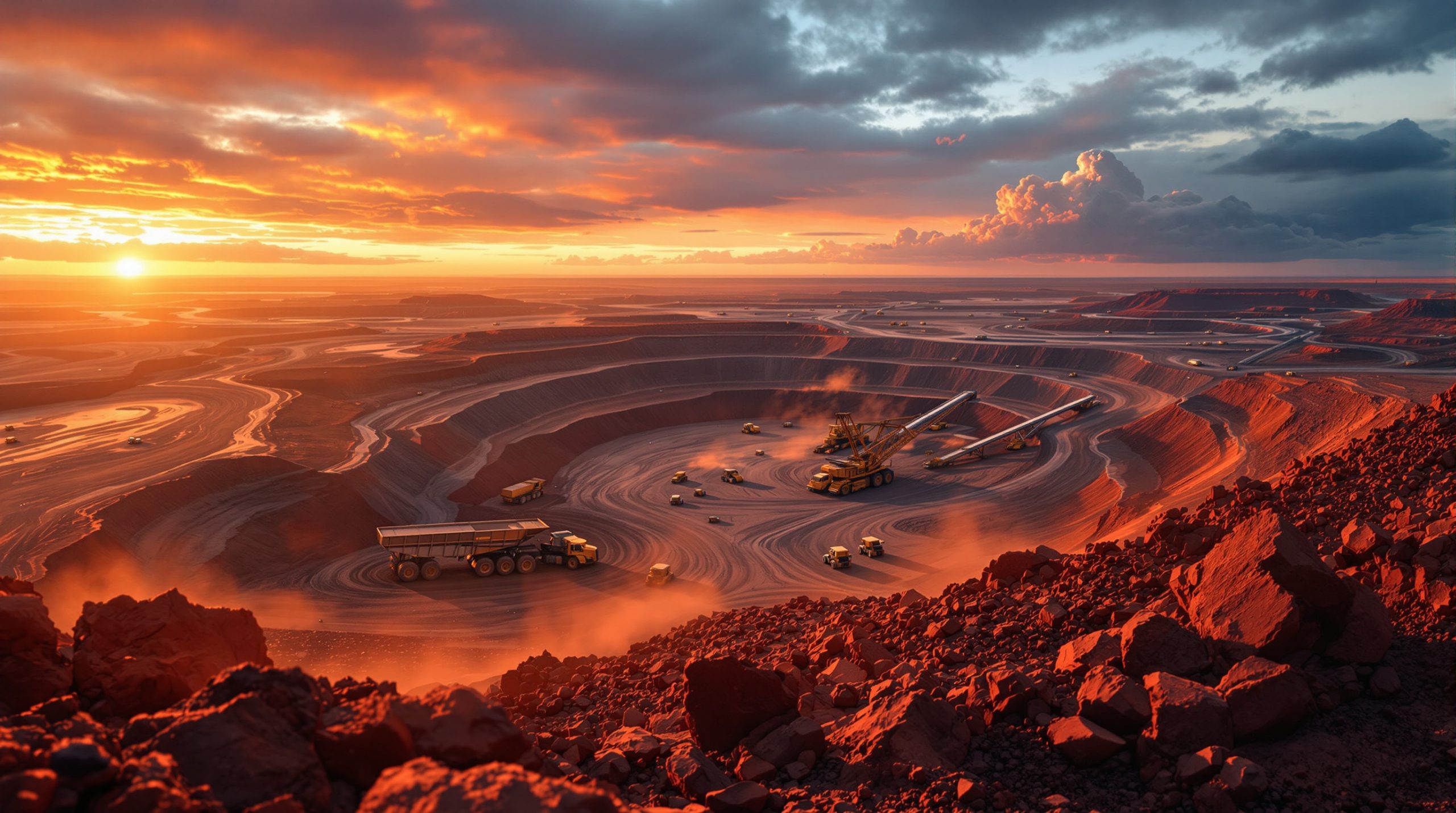GoviEx and Tombador Merger Creates Atomic Eagle: A Transformative Deal in the Uranium Sector
The uranium industry is witnessing a significant restructuring with the merger between GoviEx Uranium and Tombador Iron, creating a new entity called Atomic Eagle. This strategic reverse takeover represents a major shift in the uranium landscape, positioning the combined company to capitalize on growing global interest in nuclear energy amid ongoing uranium market volatility.
What is the GoviEx-Tombador Merger?
The merger between GoviEx Uranium and Tombador Iron marks a strategic realignment in the uranium sector through a reverse takeover structure. This transaction will see GoviEx shareholders become majority owners of an ASX-listed company, with a commanding 75% ownership stake, while existing Tombador shareholders retain 25%.
The deal utilizes a court-approved process in British Columbia, Canada, to execute the reverse takeover of Tombador Iron, an ASX-listed shell company that previously divested its iron-ore business. This merger creates a stronger, more strategically positioned uranium development company with enhanced financial capabilities.
GoviEx Executive Chairman Govind Friedland described the transaction as "transformational" for the company, highlighting how it "brings an Australian public listing, a new capital structure, a refreshed board, new substantial shareholders, a cornerstone investor with recent uranium development experience and a strengthened balance sheet."
Key Transaction Details
The merger brings together significant financial and structural advantages:
- Deal Structure: Reverse takeover of Tombador Iron (ASX-listed shell company)
- Acquisition Method: Court-approved process in British Columbia, Canada
- Ownership Split: GoviEx shareholders (75%), Tombador shareholders (25%)
- Capital Raising: Tombador to raise A$5-10 million in new funding
- Expected Cash Position: Between A$19.4-million and A$24.4-million
Financial Position of Tombador
Tombador brings substantial financial resources to the merger:
- Current Cash Reserves: Approximately A$10.4-million
- Business Status: Listed shell company (having sold its iron-ore business)
- Post-Transaction Capital Structure: Reduction from over 1 billion shares to approximately 345 million shares
This streamlined capital structure is designed to improve trading efficiency, reduce share price volatility, and provide greater flexibility for future financing activities.
Why is This Merger Significant for the Uranium Market?
The formation of Atomic Eagle comes at a pivotal moment in the uranium sector. As Govind Friedland noted, "Uranium is growing in importance and prominence in the global transition to clean energy." This strategic timing positions the new company to capitalize on increasing uranium demand as countries worldwide seek to reduce carbon emissions through nuclear power generation.
Nuclear energy is increasingly recognized as a critical component of global decarbonization efforts, providing reliable baseload power with minimal greenhouse gas emissions. The merger creates a stronger entity capable of advancing uranium projects at a time when new supply development is essential to meeting projected demand growth, especially in light of recent boost in uranium extraction across the industry.
Strategic Advantages
The merger delivers several key strategic benefits:
- Enhanced Capital Access: ASX listing provides access to deeper pools of capital specifically available for African uranium projects
- Improved Capital Structure: More efficient trading with reduced share count and lower volatility
- Strengthened Balance Sheet: Reduced reliance on short-term debt financing
- Development Focus: Resources directed toward advancing the Muntanga uranium project in Zambia
- Market Positioning: Potential for stronger valuation as key project milestones are achieved
By addressing capital structure challenges and enhancing financial flexibility, Atomic Eagle will be better positioned to advance its flagship projects through critical development stages.
How Will the New Company Be Structured?
The merger creates a balanced leadership structure that leverages expertise from both companies while introducing new strategic capabilities to guide Atomic Eagle's development.
Leadership and Governance
The leadership team combines continuity with fresh perspectives:
- CEO: Daniel Major (current GoviEx CEO) will continue in this role
- Executive Chairman: Govind Friedland (current GoviEx Executive Chairman)
- Non-Executive Directors:
- Eric Krafft (from GoviEx)
- Stephen Quantrill (from Tombador)
- Keith Bowes (former Lotus Resources MD)
- Strategic Advisor: Grant Davey (Matador Capital founder)
This leadership continuity was emphasized in the merger announcement, with confirmation that "GoviEx CEO Daniel Major will remain CEO of the combined company."
Strategic Partnership with Matador Capital
A distinctive aspect of this transaction is the involvement of Matador Capital, bringing significant uranium development expertise to Atomic Eagle:
- Track Record: Successful development of ASX-listed uranium companies including Lotus Resources and Boss Energy
- Technical Expertise: Experience in advancing uranium projects from exploration to development
- Capital Markets Knowledge: Proven ability to attract investment for resource projects
Tombador Executive Director Stephen Quantrill highlighted the value of this partnership: "Tombador acknowledges the pedigree and long history of the GoviEx team and assets, and we welcome the opportunity to work with Friedland and his team, alongside the experienced leadership from Matador Capital, to realise the potential of the GoviEx projects."
What Projects Will Atomic Eagle Prioritize?
The newly formed company will maintain GoviEx's project portfolio while establishing clear development priorities that focus resources on the most promising assets, reflecting broader industry trends detailed in recent uranium mining updates.
Primary Focus: Muntanga Uranium Project (Zambia)
The Muntanga project represents the cornerstone of Atomic Eagle's development strategy:
- Strategic Importance: Located in one of the largest and most underexplored sandstone-hosted uranium basins globally
- Development Plans: Expand project scale, improve economics, and explore wider potential
- Geological Setting: Karoo sandstones with significant exploration upside
- Project Advancement: Utilize strengthened financial position to accelerate development
Friedland emphasized the project's importance, stating that "Atomic Eagle will lead the development of the Muntanga project, situated in one of the largest and most underexplored sandstone-hosted uranium basins in the world, with considerable exploration potential."
Other Assets
While focusing primarily on Muntanga, the company will maintain its broader asset portfolio:
- GoviEx Niger: Included in the transaction with no impact on ongoing proceedings
- Exploration Portfolio: Potential for additional project development based on market conditions
This focused approach allows Atomic Eagle to concentrate financial resources on advancing its most promising assets while maintaining optionality across its project portfolio.
How Does This Transaction Benefit Shareholders?
The merger creates several potential advantages for existing shareholders of both companies, addressing structural issues while positioning for future growth in line with uranium investment strategies.
Benefits for GoviEx Shareholders
GoviEx shareholders gain multiple advantages through this transaction:
- Improved Liquidity: Access to ASX market with stronger trading dynamics
- Enhanced Valuation Potential: Better positioned for value recognition as project milestones are achieved
- Reduced Dilution Risk: Tighter capital structure with fewer outstanding shares (reduced from over one billion to approximately 345 million)
- Stronger Financial Foundation: Increased cash position without immediate dilution
- Maintained Ownership Control: 75% stake in the combined entity
These benefits directly address previous challenges faced by GoviEx, improving "trading efficiency, reducing share price volatility and giving the company more flexibility in future financing."
Benefits for Tombador Shareholders
Tombador shareholders gain strategic exposure to the uranium sector:
- Strategic Repositioning: Entry into the growing uranium sector
- Asset Diversification: Access to advanced uranium projects with development potential
- Experienced Management: Partnership with established uranium development team
- Growth Potential: Exposure to increasing global demand for nuclear fuel
This represents a significant strategic pivot for Tombador shareholders, transitioning from a shell company to partial ownership of an active uranium development company with multiple projects.
What Market Factors Support This Strategic Move?
The formation of Atomic Eagle aligns with several key trends in the global energy and resource sectors that create a favorable environment for uranium development, including the Russian uranium ban impact which is reshaping global supply chains.
Uranium Market Dynamics
The merger comes amid evolving dynamics in the global uranium market:
- Growing Importance: As Friedland noted, "Uranium is growing in importance and prominence in the global transition to clean energy"
- Supply Constraints: Limited new uranium project development in recent years creates potential supply shortages
- Policy Support: Growing government backing for nuclear energy as a low-carbon power source
- Investment Interest: Rising institutional interest in uranium development companies
These factors combine to create a potentially favorable environment for well-positioned uranium development companies.
African Mining Investment Landscape
The ASX listing provides specific advantages for African project development:
- Improved Access: ASX investors have demonstrated strong appetite for African resource projects
- Development Capital: Better ability to secure funding for project advancement
- Regional Focus: Zambia represents a mining-friendly jurisdiction with established infrastructure
The transaction strategically positions Atomic Eagle to access "deep pools of capital available for African uranium explorers and developers," as noted in the merger announcement.
What Are the Next Steps for Atomic Eagle?
Following the completion of the merger, the newly formed company will implement its strategic plan focused on project development and value creation.
Immediate Priorities
The company has outlined several near-term priorities:
- Corporate Rebranding: Complete transition to Atomic Eagle identity
- Capital Deployment: Direct funds toward advancing the Muntanga project
- Technical Studies: Continue development work to enhance project economics
- Exploration Program: Evaluate additional potential within existing license areas
- Investor Engagement: Introduce the new company to ASX investors and global uranium market participants
The merger announcement confirmed that funds "will be directed towards advancing the Muntanga uranium project in Zambia" as the company's primary focus.
Medium-Term Objectives
Looking beyond immediate priorities, Atomic Eagle will pursue several medium-term objectives:
- Project Advancement: Move Muntanga toward development decision
- Resource Expansion: Potential to increase uranium resource base through exploration
- Strategic Partnerships: Evaluate opportunities for development collaboration
- Market Position: Establish Atomic Eagle as a significant player in the uranium development sector
The company will "continue to prioritise Zambia and the Muntanga project" as it implements its development strategy.
What Challenges Might Atomic Eagle Face?
Despite the strategic benefits, several potential challenges could impact the company's development path, requiring careful management and mitigation strategies, as detailed in Mining.com's analysis of the rebrand.
Operational Considerations
Uranium project development involves specific operational challenges:
- Project Development Timelines: Uranium projects typically require extended development periods
- Technical Complexities: Sandstone-hosted uranium deposits present specific extraction challenges
- Capital Requirements: Additional funding likely needed beyond initial cash position
- Regulatory Environment: Navigating mining and nuclear regulations across multiple jurisdictions
Successful navigation of these challenges will require the technical expertise and development experience of the company's leadership team.
Market Factors
External market conditions will influence Atomic Eagle's development trajectory:
- Uranium Price Volatility: Project economics sensitive to uranium market fluctuations
- Competitive Landscape: Multiple uranium development companies seeking investor attention
- Global Economic Conditions: Resource development vulnerable to broader economic trends
- Energy Policy Changes: Nuclear energy adoption rates influenced by shifting government policies
Maintaining financial flexibility and project optionality will be crucial for navigating these market uncertainties, according to ProactiveInvestors' report on the GoviEx-Tombador merger.
FAQ: GoviEx and Tombador Merger
When is the merger expected to be completed?
While the specific completion date wasn't disclosed, the transaction is proceeding through a court-approved process in British Columbia, Canada, with necessary regulatory approvals being sought.
How will the merger affect GoviEx's listing status on other exchanges?
The announcement focused on establishing an ASX listing through Tombador, but didn't specify changes to GoviEx's existing listings.
What is the significance of the Muntanga uranium project?
The Muntanga project in Zambia is situated in one of the largest and most underexplored sandstone-hosted uranium basins globally, offering significant development and exploration potential.
How does this transaction address GoviEx's capital structure?
The merger will significantly tighten GoviEx's capital structure, reducing the total share count from over one billion to approximately 345 million shares, potentially improving trading efficiency and reducing share price volatility.
What role will Matador Capital play in the new company?
Matador Capital founder Grant Davey will join as a strategic advisor to the board, bringing uranium development expertise from his experience with companies like Lotus Resources and Boss Energy.
Disclaimer: This article contains information about a mining company merger, its potential benefits, and future plans. These statements involve risks and uncertainties, and actual results may differ materially from those described. Readers should not interpret this information as investment advice. Always conduct thorough research and consult with financial advisors before making investment decisions related to the companies discussed.
Ready to Spot the Next Major Mineral Discovery?
Discover why significant mining finds like the GoviEx-Tombador merger can create substantial investor returns by exploring Discovery Alert's dedicated discoveries page, where our proprietary Discovery IQ model delivers real-time alerts on ASX mineral discoveries, giving you a decisive market advantage. Visit https://discoveryalert.com.au/discoveries/ to begin your 30-day free trial today.




